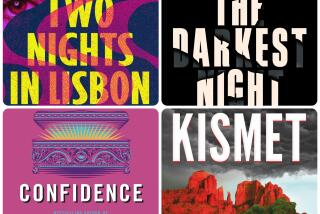A brainy action hero
- Share via
An endearing aspect of “The Da Vinci Code” phenomenon has been the creation of a new kind of action man. The boffin-as-hero, exemplified by Robert Langdon, marks a change from the traditional male adventurers of page and screen: the gun-toting muscleman, the caped superhero, the suave secret agent lethally accessorized with an exploding fountain pen. Guns and gadgets now have to make room for middle-aged professors more familiar with biblical symbolism than how to deal with ominously ticking briefcases or what to wear for cocktails in South American embassies. These eggheads may not be destined for glory as articulated dolls or interactive video games, but their ability to foil evil cults by drawing on a knowledge of dead languages and ancient statuary has undeniably captured readers’ imaginations.
One of the most capaciously learned of this new breed of hero makes his appearance in Daniel Levin’s debut novel, “The Last Ember.” Thirtysomething Jonathan Marcus is a former doctoral student in classical archaeology, the one-time “golden boy” of the American Academy in Rome (where the author himself was a visiting scholar). A tragic accident in a catacomb seven years earlier has forced Marcus to abandon academia for a lucrative legal career in Manhattan representing unscrupulous antiquities dealers. Youthful passion has been supplanted by an appetite for expensive suits and Italian shoes, but a reexamination of priorities is called for when his law firm dispatches him to Rome, where his academic career imploded.
Levin’s plot is off and running, with cryptic inscriptions (including a tattoo on the belly of a perfectly preserved 2,000-year-old corpse), networks of subterranean tunnels, even a gladiatorial battle in the modern-day Colosseum. The action switches rapidly back and forth between Rome and Jerusalem as Marcus realizes that his abandoned doctoral thesis, on an ancient Jewish espionage network, suddenly has an urgency beyond the ivory tower.
As Marcus dashes around Rome -- reunited with an old flame -- we get crash courses in Jewish history and Latin etymology. There are also inventively deployed quotations from classical authors. “Leave no stone unturned,” Marcus’ ex-lover, a U.N. official named Emili, urges him -- only to have him remind her that the Greek play from which this cliche comes is a tragedy in which everyone dies. Not all the allusions are so highbrow. There’s a nice moment when, wanted by the Italian police, Marcus manages to slip through Rome’s airport security as the guards are glued to an episode of “Law & Order.” The irony is deepened by the fact that Marcus is traveling on a forged Canadian passport. “I don’t know a thing about Canada,” he protests to the forger. It seems to be one of the rare gaps in his education.
The novel’s MacGuffin is the Tabernacle menorah, a seven-branched gold candelabrum pillaged from the Temple in Jerusalem. The Temple Mount has been well picked over by thriller writers, from Robert Stone’s “Damascus Gate” to Paul Sussman’s recent “The Last Secret of the Temple,” and it doesn’t take a Harvard professor of symbology to figure out why, at this point in time, we’re fascinated by thrillers interweaving biblical lore and front-page Middle Eastern politics. Levin’s contribution -- beyond delivering an intelligent and smartly paced thriller -- is the added spice of archaeological politics and historical revisionism. Archaeology, he shows, is about more than museum pieces: Ancient artifacts are the building blocks of history and cultural belief. And some artifacts are more coveted and contentious than others. What’s the difference, a character is asked, between the ruins in Rome and those in Jerusalem. “In Rome,” she replies, “the ruins are dead.”
Levin, however, brings the Roman ruins gruesomely to life. One of the pleasures of “The Last Ember” is that he seems to know the Eternal City’s every nook and cranny. Either that or he has a very fertile imagination. Was Rome really adorned with exotic plant life thanks to the seeds caught in the clothing of gladiators rounded up in Africa and Asia? Do eels in the Tiber eat burned flesh? No matter: This not-in-the-guidebook arcana is put to excellent use, coalescing at one point to give one character a suitably grisly end.
It’s not giving away the plot to report that Marcus survives his adventures without resorting to gadgets or guns. Let’s hope Levin brings him back to teach us, once again, the benefits of a classical education.
More to Read
Sign up for our Book Club newsletter
Get the latest news, events and more from the Los Angeles Times Book Club, and help us get L.A. reading and talking.
You may occasionally receive promotional content from the Los Angeles Times.









